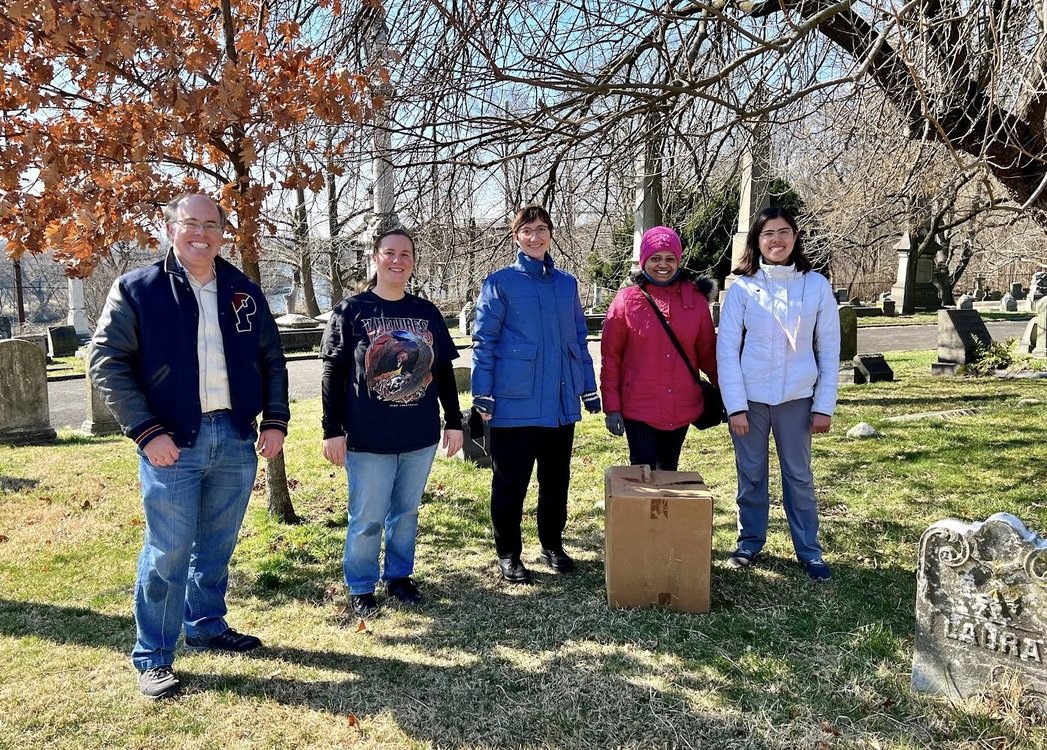Recently an injured hawk was spotted at The Woodlands. Toribird was quickly on the scene and recounts the rescue for us here:
On the evening of March 10th, I was sitting at my computer typing up a midterm paper when a message came through on a Philly birding group chat. Maddie and Surahbi, both local birders, had come across an injured Red-tailed Hawk at The Woodlands and were wondering about how to help it. I replied, suggesting that the typical best practice is to throw a blanket or other large cloth over the bird, then place it in a cardboard box for transport to a wildlife rehab center. I offered my aid, and Surabhi and Maddie felt that an additional pair of hands would be helpful. Happy for the opportunity to put off my schoolwork, I enlisted the help of my dad, Randall, and we headed to the Woodlands with a blanket and box in tow.
The Red-tailed Hawk that is the center of this story. He is likely a male due to his smaller size. Note the droop on the left wing showing an injury. Photo by Surabhi Walavalkar.
By the time I arrived, the hawk had managed to fly about 10 feet up into an evergreen tree, though it had been hanging out on the ground and on low headstones earlier. A droop in the bird's left wing revealed an injury that was impeding his flight ability. We decided to try to encourage the hawk to leave the tree and fly back to the ground by waving fallen branches around and making noise. The bird proved adamant on remaining in the tree however, and flew a couple feet higher up. Discouraged and with light fading quickly, we decided to regroup the next morning at sunrise and hope that our Red-tail hadn't moved overnight.
When I got home, I sent an email to my friend Courtney, who is a local falconer and educator, and asked if she would be available to bring her hawk trap and guide us through capture the next morning. She said that she sadly had to work in the morning, but kindly invited me to stop by and pick up the trap and other equipment. At her house, Courtney acquainted me with the trap, which is a small square of hardware mesh with a raised bubble in the center where live bait would be put but remain protected. She also graciously lent me a hood, leather welder's gloves, and a defrosted rat (from feeding her own resident birds) that we could try to use for bait.
The following morning at 7am, Surabhi, Maddie, my dad and I met at The Woodlands. The Red-tailed Hawk was still in the same tree. He seemed to be at least partially searching for prey, as he was looking around and doing that lovely raptor head bob whenever something caught his eye. With the dead rat we were eventually able to attract the hawk to the ground, though he didn't get in the trap. We decided to try to capture him under the blanket nonetheless, but were not successful. The hawk was clearly injured, as he did not try to fly immediately, but even so he was incredibly quick as he darted away across the dewy lawn like a little velociraptor! He eventually flew up to another low tree branch. We took the opportunity to pause, regroup, and re-evaluate.
The rule of thumb for adult wildlife is "if you can catch it, it's in trouble". This bird seemed to be something of a borderline case, so we wanted to make sure that capturing the hawk was truly necessary and wouldn't end up doing more harm than good. I texted Courtney and also called the Schuylkill Center Wildlife Clinic's hotline, recounting the story and asking for advice. Both were of the opinion that, despite being quick on his feet, the hawk was handicapped enough that he would benefit from a rehabber's care. By this point, pet stores had opened and I sent my dad out to pick up a feeder rat pup - fresh food is always more enticing than a half-frozen meal!
A video summary of the capture by Maddie Hewitt.
Now ready with live bait, we were going to attempt capture again. Happily, Courtney's late morning work appointments happened to be cancelled, so she was able to join and guide us all through. The hawk was quite interested in the rat pup, and he danced around on top of the trap, trying to figure out how to get to the prey. Meanwhile, we waited for him to hit the trap at the right angle to be caught. Ten minutes later, the hawk was snared and we sprinted over, throwing the blanket on top to help secure the hawk for both his safety and ours. As the legs are the real 'business end' of raptors, I held them securely while Courtney put on the hood - hawks are visual hunters, and this has a calming effect on them. The hawk displayed an interesting flopping reflex, going limp in what was likely an instinctive response to being handled. Safely placed in the cardboard box, the bird was then driven to the Schuylkill Center.
Several days later, I emailed the rehab clinic for an update. It appears that the Red-tail had suffered an injury around the radius and ulna bones in the wing some time ago. He was also in poor condition from a lack of sufficient food. He is currently housed in an outdoor enclosure where he can exercise, and is receiving physical therapy, pain management, and plenty of high-quality food. With this care he has fully regained flight and will soon be able to be released and soar over Philadelphia once more!
The full hawk rescue group. From left to right: Randall Sindlinger, Courtney Doudes, Maddie Hewit, Surabhi Walavalkar, and Victoria Sindlinger (Toribird). Photo taken by Jessica Baumert.



